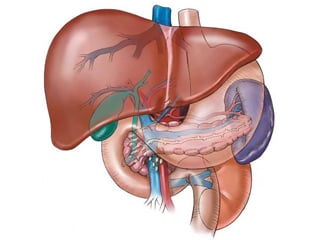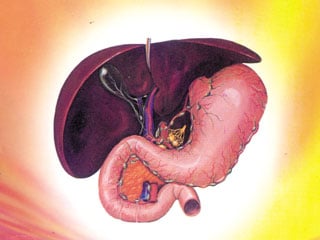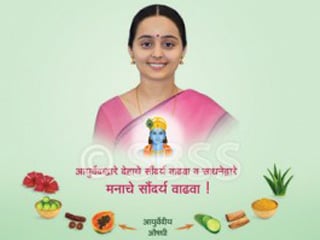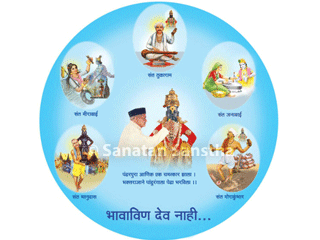Contents
- 1. Blood (rakta) – Ayurvedic concept
- 2. Liver (Yakrut)
- 2.1 Life depends on the liver
- 2.2 Close association of blood and the liver in foetal life
- 2.3 Functions of the liver
- 2.4 Why does the tummy of an infant appear bulging?
- 2.5 Why is liver disease commonly suspected in infants and children?
- 2.6 Causes of liver disorders
- 2.7 Causes of jaundice (modern concept)
1. Blood (rakta) – Ayurvedic concept
Blood is a red fluid which is neither very thick nor very thin. The blood stains on cloth can be removed completely by washing. The quantity of blood in an adult is five litres, that is eight anjalis, i.e. the cavity formed by joining the ulnar surfaces of both the palms. The words asruk, rudhiram, lohitam, shonitam are sometimes used synonymously with rakta (blood)
1A. Qualities of blood
Blood is slightly warm, salty, sweet, heavy, oily and with a peculiar odour. Its smell is derived from the absolute earth (pruthvi) element, its viscosity from the absolute water (apa) element, its red colour from the absolute fire (tej) element, its pulsatile and mobile nature from the absolute air (vayu) element and its lightness from the absolute ether (akash) element. Rohinis (arteries) carry the blood from the heart to various parts of the body and the nilas (veins) carry the blood from different parts of the body to the heart.
1B. Functions of blood
Blood is called life itself as life depends on blood.
-
Blood carries oxygen to various parts of the body ‘प्राणा: शोणितं अनुवर्तन्ते’ and carries carbon dioxide i.e. gaseous waste products to the lungs.
-
Blood constantly supplies nourishment to all the sense and motor organs, tissues and organs of the entire body and carries the waste products to the kidneys, skin and large intestine
-
It imparts a reddish tinge to the skin.
-
Skin is the sense organ of touch.
-
It supplies nourishment to the foetus.
-
In the foetus, the liver, spleen, lungs, intestines, appendix, kidneys, testes, heart, arteries and veins are derived from the endothelium of blood.
-
In women, blood is purified every month due to monthly menstrual flow.
1C. Qualities of a person with ideal blood
The skin, nails, tongue, lips, eyes, mouth, palate, nose, palms, soles, forehead and glans penis of such a person appear reddish, oily and lustrous. These individuals have moderate strength. They are unable to bear exertion and heat. They have a good digestive power. They are happy, delicate, intellectual and egoistic.
The blood volume in the body is not constant and may increase or decrease or the blood may get vitiated.
1D. Increase in quantity of blood – Polycythemia (raktavruddhi)
1D 1 Symptoms: The entire body and eyes appear red. The veins appear swollen and the body becomes heavy. The patient suffers from a burning sensation, dullness, excessive sleep, enlargement of the liver and spleen, skin diseases and bleeding disorders
1D 2. Treatment: The treatment consists of blood letting and removing 50 ml. to 100 ml. of blood intermittently and treating the root cause.
1E. Decrease in quantity of blood – Anaemia (raktakshaya)
1E 1. Symptoms: Pallor of the mucous membranes, nails and skin. The skin becomes dry, rough and lusterless. Desire to eat cold and sour food items. The patient suffers from loss of appetite, weak digestive power and hiccoughs, cough and breathlessness. The entire body and the tissues become weak due to inadequate supply of nutrition. If the brain does not get adequate blood supply, the patient suffers from loss of hearing, giddiness, fainting and loss of consciousness.
1E 2. Treatment in anaemia where iron deficiency is not the cause: Some types of anaemia are due to folic acid deficiency. Food items which are rich in folic acid are liver, mutton, fish, pulses, leafy vegetables and sour fruits. In such cases the following Ayurvedic recipes are useful –
-
A decoction of haritaki, manjishtha and rohitaka.
-
A decoction of patola, sariva, musta, patha, katuka, amalaka and guduchi.
-
Two teaspoonfuls of shatavari ghruta twice a day.
-
Two teaspoonfuls of tikta ghruta or mahatikta ghruta twice a day.
-
Two teaspoonfuls of panchagavya ghruta twice a day.
-
Two teaspoonfuls of kalyanaka ghruta twice a day.
1E 3. Diet beneficial in anaemia according to Ayurvedic concept:
Cereals : Wheat, bajra, vari and rajgira.
Pulses : Peas, kulattha (horse gram), chana (gram) and udid (black gram).
Milk products : Milk, curds, butter and buttermilk.
Vegetables : Onion and stem of lotus flower.
Fruits : Mango, watermelon, banana, jackfruit, sweet lime, orange, amalaka and nimba.
Meat : Mutton, liver and egg yolk.
Dry fruits : Kharik, dry coconut, pista, badam (almond) and charoli.
Sugar based products : Sugarcane juice and honey.
Harmful diet : Oil, groundnuts and ksharas (caustics).
1F. Vitiation of blood (raktadushti)
1F 1. Symptoms:
General : Pain in the body, heaviness of the body, redness of the eyes, weakness, etc.
Related to the skin : Skin diseases like kushtha, visarpa, vang, masa, til, white spots on the body, ecchymosis, redness and inflammation of the mouth and the perianal region, discolouration of the skin, excessive sweating, itching, ulcers and foul body odour.
Related to the nervous system : Anger, intoxication, tremors, excessive sleep and giddiness.
Miscellaneous : Gout and bleeding disorders
The treatment is to diagnose and treat the root cause.
1G. Blood – Modern concept
1G 1. Components of blood:
-
Red blood cells
-
White blood cells
-
Platelets
-
Plasma
1G 2. Sites of blood formation: In a foetus of less than 2 months, blood is formed in the yolk sack. Between 2 to 7 months of foetal life, blood is formed in the liver and spleen. After 3 months, the blood formation starts in the bone marrow. At birth and thereafter throughout the life, the bone marrow is the only site of formation of red blood cells, platelets and polymorphs (a type of white blood cells). Production of lymphocytes and monocytes occurs mainly in the spleen, lymph nodes and other lymphoid tissues.
1G 3. Development of blood cells: The mature blood cells seen in blood circulation are derived from the precursor cells present in the bone marrow. The pronormoblasts present in the bone marrow mature and give rise to red blood cells. The myeloblasts in the bone marrow mature to form polymorphonuclear leucocytes, the monoblasts in it mature into monocytes and the megakaryoblasts in it mature into platelets. The lymphoblasts in the lymph glands and the spleen mature into lymphocytes. Erythropoietin formed mainly in the kidneys and in the liver to some extent, stimulates the formation of mature red blood cells by stimulating the bone marrow whenever there is lack of oxygen due to a decrease in the number of red blood cells. Erythropoietin levels are raised in all types of anaemia and in those who reside permanently at high altitudes. In diseases of the bone marrow such as aplastic anaemia and myelosclerosis, the patient suffers from anaemia and decreased number of polymorphs and platelets
2. Liver (Yakrut)
2A. Life depends on the liver
It is said that life depends on the liver. Here, the word liver is used with a double meaning, that is liver as an anatomical organ of the body and liver which implies one who lives, i.e. the lifestyle of an individual.
In Ayurveda the word ‘yakrut’ is used for liver. This word is derived from ‘yaha’ i.e. one and ‘krut’ which literally means ‘does’. Thus the word yakrut means an organ which is always active and performs important metabolic functions of the body.
2B. Close association of blood and the liver in foetal life
As described in Ayurveda, the liver is an abdominal organ situated below the heart on the right side of the abdomen. According to Sushrut, the liver and spleen originate from blood and the endothelium (raktadhara kala). According to modern medicine, in foetal life, blood is manufactured in the foetal liver and spleen. During the last three months of pregnancy, the function of manufacturing of blood is taken over gradually by the bone marrow. After birth, the liver and spleen become the storehouses of blood.
Bile is called as ranjak pitta. The word ranjak means that which imparts colour. The yellow colour of bile is due to bilirubin which is ranjak pitta. When pitta i.e. bile enters the intestines through the bile ducts, it imparts yellow colour to the digestive juices and faeces. In ruddhapathakamala i.e. obstructive jaundice, the stools become white in colour because the small bile canaliculi are obstructed by the sticky vitiated bile.
Vagbhat states in the Ashtangahruday that toxins affect the liver and spleen. Blood has a special affinity for toxins and as the liver and spleen are the storehouses of blood, the toxins lead to hepatosplenomegaly i.e. enlargement of the liver and spleen.
2C. Functions of the liver
-
Maintaining the level of bile pigments in the blood: The dead red blood cells release haemoglobin which is converted into indirect bilirubin. This indirect bilirubin in the blood is absorbed by the liver cells and it is converted into direct bilirubin which is carried to the intestines through the bile ducts. This bile is called as ranjak pitta in Ayurveda. The word ranjak means that which imparts colour. The bile pigments are responsible for the yellow and green colour of the bile, stools and urine. Swelling of the liver cells in hepatitis or obstruction of the bile ducts raises the level of bilirubin in the blood and leads to jaundice
-
The haematopoietic cells in the liver manufacture foetal haemoglobin. This formation of red blood cells containing foetal haemoglobin stops when the infant is around two months of age.
-
Production of important biological molecules: The amino acids, fatty acids, glucose and glycerides which are formed in the intestine after the digestion of food are carried by the blood capillaries and lymphatics to the liver. In the liver cells, albumin which is important for maintaining osmotic pressure in the blood capillaries and prothrombin which is essential for the clotting of blood are formed, which circulate in the blood.
-
Storage of food: Glucose is stored in the cells of the liver in the form of glycogen. If the glucose level in the blood falls as in the case of fasting or after exercise, the liver cells convert the glycogen into glucose and thus maintain the level of blood glucose. In addition, iron and vitamin B12 are also stored in the liver.
-
Digestion of food: The liver cells manufacture bile which is carried to the gall bladder and stored there. During the digestion of food, the bile stored in the gall bladder is secreted into the intestine. About 600 ml. of bile are manufactured daily. The bile salts in the bile help in the digestion of oil, ghee and fatty substances.
-
Detoxication: The liver cells detoxicate i.e. convert poisonous substances and drugs into harmless substances which are carried by bile into the small intestine and later excreted in the form of stools.
2D. Why does the tummy of an infant appear bulging?
In the foetus, the size of the abdominal cavity is very small. Hence the abdomen cannot accommodate the intestines. The abdominal cavity in the foetus gradually increases in size and after six months it can accommodate the intestines.
However, this results in bulging of the abdomen till the age of one to two years. As the size of the abdomen further increases after birth, the bulge reduces. In addition, the liver is a comparatively large organ in infants. This is also responsible for bulging of the abdomen in infants. In infants and children with a weak digestive power and malabsorption, the intestinal wall becomes weak and it bloats easily as a result of formation of flatus due to the weak digestive power. In rickets, the muscle tone of the abdomen as well as the intestines is affected and this results in bulging of the abdomen.
Enlargement of the liver and spleen, accumulation of fluids in the abdomen i.e. ascites, tuberculosis of the intestine and constipation can also give rise to bulging of the abdomen.
2E. Why is liver disease commonly suspected in infants and children?
The liver is comparatively large in infants. It constitutes 5% of the total body weight at birth but only 2% of the body weight in adults. In adults, the liver is completely covered by ribs on the right side of the body and is not palpable with the fingers. In infants, due to the comparatively large size of the liver, it can be easily palpated by the doctor during examination of the abdomen. The liver is also enlarged in many infectious diseases in infants. Hence in many conditions like loss of appetite, distension of the abdomen, indigestion and diarrhoea, the large liver is suspected to be the causative factor.
2F. Causes of liver disorders
Dietary causes –
-
Fasting for a long time along with malnutrition.
-
Eating in excess.
-
Eating incompatible food items.
-
Indigestion
-
Eating allergic (asatmya) food items not suitable for one’s constitution.
-
Eating heavy, cold and dry food items.
-
Alcohol consumption.
-
Viral infections such as hepatitis A, B, C, D, E and G.
-
Drug induced hepatitis: Most drugs are detoxicated in the liver and in this process the liver cells may get damaged.
-
Both obesity and malnutrition make an individual susceptible to liver diseases.
-
Metabolic disorders: Wilson’s disease in which the liver functions are affected due to accumulation of copper in the liver.
2G. Causes of jaundice (modern concept)
An increase in the level of the bile pigments i.e. ranjak pitta in blood gives rise to jaundice. The normal level of bile pigments in blood is 0.8 mg.% – 1.2 mg.%.
2G 1. Haemolytic jaundice: In this disease, there is increase in the formation of bile pigments. The destruction of red blood cells releases haemoglobin from which indirect bilirubin is formed. The increased destruction of red blood cells leads to jaundice. This increased destruction of red blood cells can be acute or chronic. This type of jaundice is called haemolytic jaundice.
2G 2. Acute destruction of red blood cells
-
Incompatible blood: Blood transfusion with mismatched blood leads to sudden destruction of the red blood cells thus causing jaundice. If the father and the newborn baby have Rh positive blood group and the mother has Rh negative blood group or if the father and the newborn baby are of ‘A’ group and the mother is of ‘O’ group, the baby may suffer from intense jaundice in the first 2 to 3 days after birth. In these cases, exchange transfusion may be required.
-
G-6-PD deficiency: The red blood cells contain an enzyme called as G-6-PD. Due to this enzyme, the red blood cells can utilise glucose for the formation of energy. If there is deficiency of this enzyme, the red blood cells cannot utilise the glucose and die early. Administration of drugs like quinine, aspirin, sulpha, chloromycetin and nitrofurantoin precipitates the destruction of red blood cells in such cases. These drugs should be avoided in individuals with G-6-PD deficiency. In such cases, the level of bilirubin in the individual increases.
-
Chronic destruction of red blood cells: In diseases like Cooley’s anaemia, sickle cell anaemia and congenital spherocytosis the structure of haemoglobin is abnormal. Hence the red blood cells in these patients die within 30 to 35 days instead of a normal lifespan of 100 days. In such cases, the liver and spleen get enlarged and the patient suffers from intermittent jaundice. The bone marrow tries to compensate for this loss by increasing the manufacturing of the red blood cells. As a result, the reticulocyte count in the blood increases.
2G 3. Obstructive jaundice: Obstruction in the bile ducts results in accumulation of bile in the liver cells which in turn enters the blood and gives rise to increased level of bilirubin in the blood, resulting in jaundice. Due to the absence of bile in the intestines, the stools become white in colour and greasy as there is insufficient digestion and absorption of fat. The urine becomes dark yellow in colour.
In infective hepatitis caused by viruses, swelling of the liver cells obstructs the fine bile ducts and gives rise to jaundice. In some babies, the bile ducts are not formed in foetal life. In such babies, the jaundice is apparent in the first few days after birth and it steadily increases.
2G 4. Infective hepatitis: This jaundice is caused by hepatitis viruses which are named as A, B, C, D, and E.
2G 5. Cirrhosis of the liver: This is a chronic gradually progressive disease of the liver wherein the liver cells die and are replaced by fibrous tissue i.e. scar tissue. Many bile ducts are obstructed by the scar tissue. Hence the level of jaundice keeps on increasing gradually.


 Global market position of Ayurvedic products
Global market position of Ayurvedic products Blood and liver disorders
Blood and liver disorders Supreme beauty of body, mind and soul
Supreme beauty of body, mind and soul What is the real beauty?
What is the real beauty? How does sattvik mind help in leading blissful life?
How does sattvik mind help in leading blissful life?